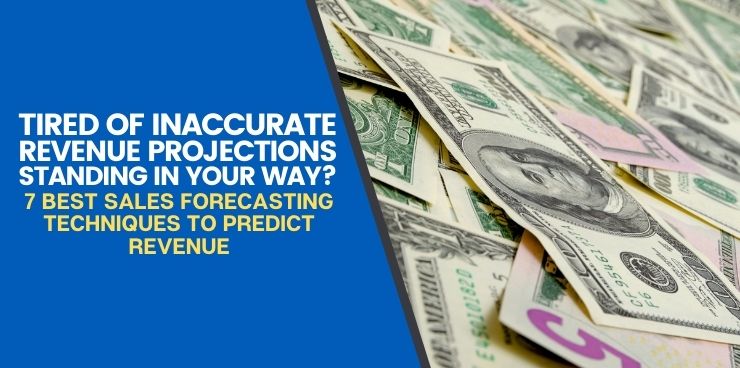“Predictability” may not be the first word you think of when you think of running your own business. We’re also willing to bet that it isn’t a word that comes to mind too fast when you think of your sales department. Did we get it right?
In a sense, that can be true.
Sales projections may keep landing way below the mark for you. Sales reps call in sick, sales managers aren’t pushing your reps to be the best they can be, the list goes on.
We’ve been there. You’ve been there. Your next-door competition has been there.
But you don’t have to stay there.
There are sales forecasting techniques that actually work, and we have them listed out here for you today.
It’s time to throw your old, barely working sales forecast methods out the window. It’s also time to stop thinking of statistical forecasting as your only option when it comes to predicting revenue. Without the right sales forecasting techniques, you cannot account for an accurate budget. Things start to fall behind, stress piles up and morale drops low.
Not anymore.
The 7 Best Sales Forecasting Techniques
Say it with us:
You. Can. Predict. Growth. And revenue.
But to begin with, there are a couple questions you want to be able to answer with the sales forecasting techniques you end up using.
First: How much are you intending to sell?
Second: By what date can you get that done?
As you are familiar with, there are plenty of unforeseen circumstances that pop up in sales, or in your particular business as a whole. Mama didn’t raise no oracle, and all that.
While that very well may be, we have seven of the best forecasting techniques right below. After you adopt these, you can think of each one as a forecasting strategy that will take into account all those unforeseen circumstances.
You need sales forecasting techniques, or sales forecast methods. These will consider, and evolve with, any number of variables that arise.
Want some good news? We have them.
 The Five Simple Questions
The Five Simple Questions
There are a lot of “rules” and “dos and don’ts” you come across as you research how to do sales projections. As with most things, though, a simple approach is always the best place to start. This is especially true with sales forecasting techniques.
Similarly, when a lot of entrepreneurs start their business forecasting process, they only account for a few variables. They think of those initial two questions and stop there.
These five questions you’re about to read about keep it simple, but also go beyond the bare minimum. Introduce this set of questions to your sales department so that they can build upon them as they create their sales forecasts…
- Who? We have moved away from the idea of “the customer is always right.” But you still have to acknowledge that your customers (and potential customers) should always be at the center of what you do. Start making your forecasts with your prospects as the foundation. What is your prospect’s role in their company? Questions like that will help you get a better understanding of who you have to appeal to.
- What? With your prospect in mind again, what are their pain points? What problem are they trying to solve, and how are you going to help them solve it with your product or service? Structure your forecast around the specific product or service you want to sell and always remember your unique value proposition.
- Where? Again, think of your prospect. Where are they purchasing from, physical-location wise? In what location will they be using your product or service? You will find that your sales and market forecasting is way more accurate when your sales department knows all the details like this.
- Why? Think of what is driving your prospect to action with this question. What is their reason for looking to buy your product in the first place? If they are a returning prospect, what changed their mind this time around?
- How? Look into your prospect’s buying behaviors. How have they made, and continue to make, purchasing decisions both in the past and now is critical information. You can build from there.
The Negative Forecasting
As far as forecasting methods go, negative forecasting can play a pretty big role.
Negative forecasting is when you use your forecast to analyze what risks your business is currently facing.
There are plenty of risks you could find as you start your analysis, and one of the best ways to really figure them out is through a SWOT analysis. With a SWOT analysis, you will determine your business’s:
- Strengths (Internal factors)
- Weaknesses (Internal factors)
- Opportunities (External factors)
- Threats (External factors)
As you start to dive into your SWOT analysis, you want to analyze everything as objectively as possible. Here are some examples of common threats, which are similar to the risks you might find in negative forecasting:
- Large-scale inclement weather conditions, like earthquakes or hurricanes
- Fluctuating costs of materials you need for your products
- More competition coming into your market
- Shortages in labor
- Global crises, like the COVID-19 pandemic
The Buyer’s Intentions
This is a vital method among sales forecasting techniques.
Remember how we said above that your customers and prospects, and their journey, need to be at the frontline of all your actions and efforts?
That holds true, and you can assume that it always will. To reflect that, you want to compile and send out a survey of your buyers’ intentions.
To do this, start with creating an extensive list of all your potential customers. Pick a handful of those potential customers to conduct face-to-face interviews with.
As for your interview questions, you want to ask questions that will help you and your team figure out– you guessed it– their intentions as a buyer.
From there, you can make an educated estimate of how many products you will sell and how much you will make from said sales.
Industrial goods marketers favor this method among many other sales forecasting techniques. Instead of a one-sided technique, think of this one as a kind of sales forecast methodology that places the customer at the heart of your selling processes.
Opinions of the Experts
You have some selling pros who you look up to as you shape your own forecasting strategies and sales processes, right?
If we guessed correctly, you have a lot of these so-called idols. After all, you have to draw your inspiration from somewhere (or someone).
What you might not realize is that a lot of these experts are not that far out of your reach. Some of them might be current or former employees of a business you once worked for yourself. Others could be top executives at companies where you share a common network.
Touch base with them. If they are in your industry or network, they might have some deeper insights to offer. They might be able to explain to you how you can improve your sales forecasting techniques for your specific needs.
Conduct Direct Market Test
Some sales forecasting techniques work best if you pair them with others, as a sort of supplement. Others are dandy on their own. A direct market test can work both ways. Once you have your direct market test, you can mold your sales forecast around your discoveries.
Consumer goods marketers and industrial marketers (again here) are big fans of this forecasting method.
Past Sales Projection
What did your projection look like last year? How can you improve upon that projection with new sales forecasting techniques?
A deeper look at your sales projection from last year can help you pinpoint the areas that need improvement and the ways in which you hit the nail on the head.
As you can expect, you want to improve those lacking areas and optimize what worked even further. Pick specific parts of your previous projection. Then, pick specific steps you can take to improve them.
For example, add or take away a certain percentage of last year’s sales and make your new forecast with that data in mind.
This is a more conservative approach among many other sales forecasting techniques.
 Statistical Analysis on Demand
Statistical Analysis on Demand
What factors cause the most variation in your sales? Think deep when it comes to these sorts of sales forecasting techniques. You have a lot of possibilities here.
Some of these variables can include:
- Product pricing
- Frequency of discounts, or clearance/sale events
- Changing income circumstances of your target market
- Population bursts and declines
- Global events
- Your marketing and advertising approaches
Then, start to build your forecast with that information. SaaS and IT sales companies often turn to this technique for sales forecasting.
How Sure Are You of Your Current Sales Forecasting Techniques?
So, what’s your answer? How sure are you of the sales forecasting techniques you’re using right now?
If your answer was “eh,” or “not super…” then it’s time for a change.
Here at Selling Revolution, we know all about changes, and how often they can happen to the extent that they impact your business.
You end up with a whole lot of evolutions. But don’t you want a selling revolution to match?
Our pro team has countless decades of experience in helping businesses like yours. We can get you better leads, higher conversion, and quality sales team training.
If you’re anything like us, that’s the sort of stuff you need.
Click here to book a call with Selling Revolution today and begin your own revolution.


 The Five Simple Questions
The Five Simple Questions
 Statistical Analysis on Demand
Statistical Analysis on Demand